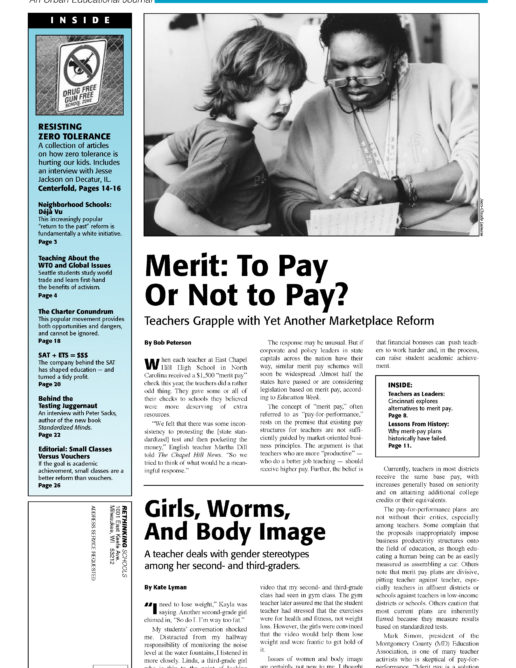Preview of Article:
Merit
Teachers Grapple with Yet Another Marketplace Reform
Momentum for merit pay plans got a boost in November at the 1999 National Education Summit of governors and business leaders. The summit called on districts to implement “pay-for-performance incentive plans … based on lessons learned from the private sector.”
On the state level, political leaders have responded to the summit’s call. Wisconsin’s governor, Tommy Thomp-son, National Education Summit co-chair, announced a typical plan in his state-of-the-state address in January. Thompson proposed an “Award for Achievement” program in which teachers at schools that test 95% of their students and show year-to-year gains could receive “financial awards of up to $3,000.”
The media have also promoted merit pay. When Denver teachers approved a new contract last fall that included provisions to experiment with three types of merit pay, the contract was top news on television stations and in newspapers across the country.
Although rarely noted in the media, merit pay proposals are not new. As educational historians Larry Cuban and David Tyack point out in the article on page 11, merit pay proposals in the United States have been around since World War I – and have invariably clashed with the efforts of teachers to ensure that “the fundamental intrinsic equality of all good teaching” is recognized.
Bob Chase, head of the National Education Association, and Sandra Feldman, head of the American Federation of Teachers, both emphasize that the key issue is ensuring that all teachers are paid commensurately with their training. In a speech this January, for instance, Chase noted that unionists are understandably wary of pay-for-performance. “We remember past experiments with merit pay – compensation schemes that pitted teacher against teacher,” he said. “We know that every one of those merit pay schemes was a counter-productive disaster.”</p

